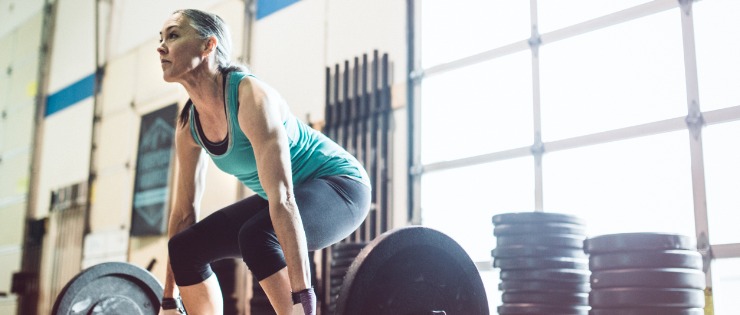
By the time a woman celebrates a half century, her body doesn't have the muscle mass it had at 30 or even 40. In fact, most women lose 3%-5% of their muscle every decade from the age of 30.
Exercise such as walking, swimming and cycling are great cardiovascular workouts, but strength training can help keep your body younger and stronger for longer. A little strength training a few times per week can turn back your body’s biological age and allow you to enjoy a long, strong second half of life.
Benefits of Strength Training in Your 50’s
The benefits of strength training in your later years are many and varied. More muscle and less fat can reduce your risk of falls, chronic disease, depression and back pain, to name just a few.
Improved Balance
By increasing the strength in your legs, shoulders and back, you can reduce your risk of losing balance. Strong core muscles can hold the upper body more effectively to further improve balance. Good balance is important because a fall in your later years can result in life-altering injuries such as a broken hip.
Reduced Muscle Loss Through Aging Process
Known as sarcopenia, age-related muscle loss begins in the 30s. The average loss is 5% per decade but strength training can slow the loss and even turn it around. Despite what some people think, it’s possible for women over the age of 50 to increase their muscle mass.
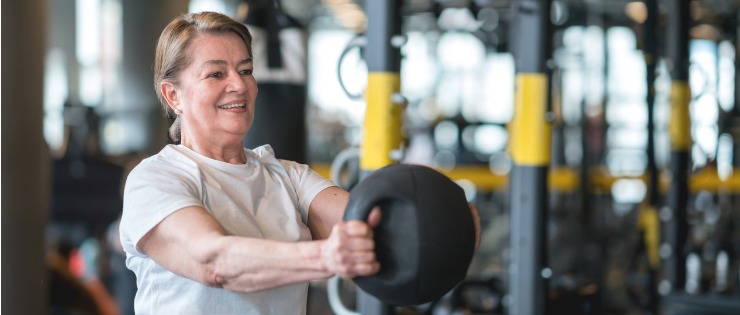
Keeps Excess Weight Off
Ageing makes it harder to keep our weight in check. One possible reason is the lipid turnover in fat tissue decreases with age even if our diet and exercise stay the same. Many women report increased weight gain particularly around the stomach after menopause. Being overweight can increase the chance of chronic health conditions such as Type 2 diabetes, heart disease, some cancers and stroke. Excess fat also places pressure on organs such as the heart and lungs. Strength training can help shed the unwanted kilos and start replacing the fat with muscle.
Improved Mood and Mental Health
Exercise increases your level of endorphins, our natural mood lifters. Many women lose self-confidence with age, but achieving your exercise goals and seeing positive changes in your body can give you a sense of accomplishment. Doctors and psychologists prescribe exercise instead of mood-boosting drugs to help with low mood.
Reduced Stress Levels
Exercise is a natural stress reliever. By doing some exercise you’re reducing your level of stress hormones, cortisol and adrenaline, and improving cognitive function. Being able to think clearer after exercise can help with problem solving.
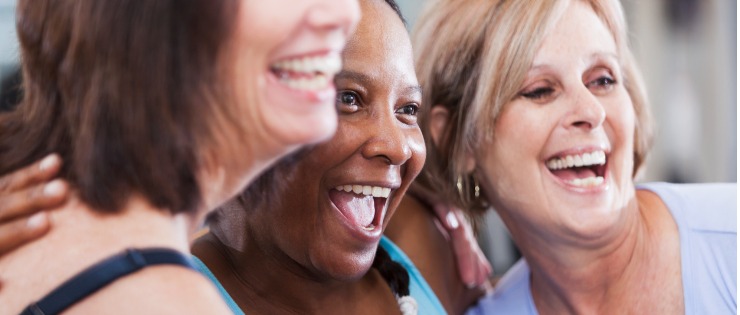
Improved Posture
Later in life, the spine naturally curves giving elderly people a hunched over look. By exercising and improving your posture, you can keep your back straight and your shoulders back. A good posture keeps bones and joints aligned and in good working order.
Reduced Back Pain
Strength training can increase back and core muscles which support the spine. A stronger back can lead to reducing pain commonly found in the lower back. A stronger back increases mobility.
Feeling Fit and Strong
Much of our outlook on life is how we feel. Strength training can make you feel fitter and stronger so you’re more likely to stay active in the community. In later years, it’s common to feel weak and vulnerable, so elderly people stay home and miss out on activities they would enjoy.
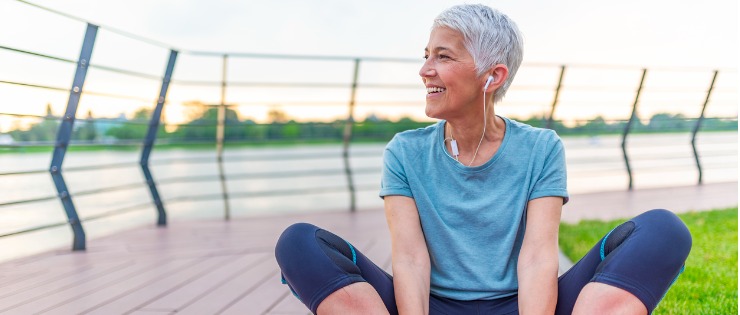
Better Quality Sleep
Many people find it harder to fall asleep and stay asleep in their later years. Getting plenty of sleep in your 50s forms good sleep hygiene habits for later in life. Sleep also protects the brain from damage. Studies have found that getting enough sleep in your 50s and 60s is important to protect you from dementia later in life. Getting six hours or less sleep per night increases the risk of dementia by 30% compared to seven hours of sleep.
Improves Metabolism
Metabolism slows as we age but our love of food and drink doesn’t. Soon we’re consuming more calories than we burn off leading to increased weight. Muscle, even when resting, burns more calories than body fat. So weight training to increase muscle mass will improve your body’s metabolism.
Reduced Risk of Osteoporosis
Weight bearing exercise can reduce the risk of osteoporosis, particularly after menopause. For women who already have osteoporosis, strength training can build muscle which helps protect brittle bones from fractures and breaks.
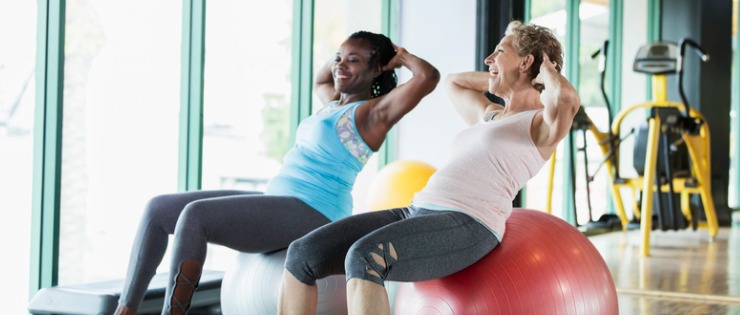
Best Weight Training Exercises
Weight training doesn’t just have to be lifting weights. There are plenty of exercises you can do to keep things interesting. And not all of them require you to lift weights to benefit.
Bodyweight Exercises
If you don’t have any weights or want to start off without using them, these are great exercises that use just your body’s weight. These exercises are ideal to start weight training over the age of 50 if you haven’t done any training before.
Kneeling Push Ups
Push ups are ideal for improving the core muscles and upper body. A kneeling push-up is a good modification from the standard push up which is difficult for beginners.
How to:
Start on your hands and knees, looking at the floor.
Place your hands on the ground shoulder width apart. Place your knees at a comfortable distance apart.
Inhale as you slowly lower your elbows and bring your chest toward the ground. Keep your core muscles contracted.
Pause for a second at the lowered position — with your chin close to or touching the ground.
Exhale as you push up from the ground back to your starting position.
Plank
The plank is excellent for building core strength. Planks don’t take long to do but offer significant benefits for little time. Planks require you to hold yourself up with your arms and biceps, toning and developing arm muscles. Planks can also build back muscles which provide stability and support for the entire back.
1. Place your hands slightly wider than shoulder width like you’re about to do a push-up.
2. Ground toes into the floor and squeeze your glute muscles. Be careful not to lock or hyperextend your knees.
3. Keep your neck and spine straight and look at a spot on the floor about 30cm beyond your hands. Your head should be in line with your back.
4. Hold the position for 20 seconds. As you get more comfortable with the move, hold your plank for as long as possible without compromising your straight line or breathing.
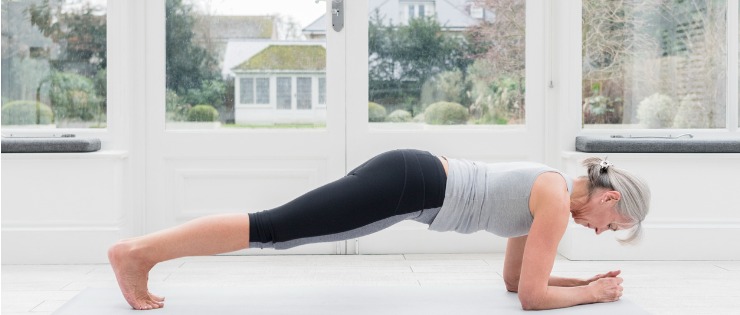
Squat
Squats are ideal for building strong leg and glute muscles which help with balance and mobility in your senior years. The deeper the squat, the more you work your glutes.
Stand with your feet hip-distance apart and your hips, knees, and toes all facing forward.
Bend your knees and extend your bottom backwards, similar to the action of sitting into a chair. Keep your weight on your heels, knees behind your toes and chest up. Rise up and repeat.
To make the exercise harder, you can hold dumbbells.
Bird Dog
The bird dog is one for the back, hips and core muscles. The exercise improves stability, encourages a neutral spine and good posture, and helps relieve lower back pain.
Begin on all fours and place your knees under your hips and your hands under your shoulders. Keep your spine straight and abdominal muscles engaged.
Raise your right arm and left leg, keeping your shoulders and hips parallel to the floor and tuck your chin into your chest to look at the floor.
Hold this position for a few seconds, then lower your arm and leg back down to the starting position.
Raise your left arm and right leg and hold for a few seconds.
Roll Ups
Roll up exercises improve the strength in your abdominals, shoulders and back.
Begin by lying down on the ground and extend your arms overhead. Flex your feet and straighten your legs.
Inhale then lift your arms up. Curl your chin to your chest and exhale as you roll your torso up to reach towards your toes, engaging your abs and keeping your legs straight throughout.
Inhale and begin to roll back down your spine, one vertebra at a time.
Exhale as the upper section of your back reaches the ground and slowly reach your arms back overhead.
Glute Bridge
As the name suggests, this exercise works the glute muscles, hamstrings and quads.
Begin by lying on your back, bend your knees and keep your feet flat on the floor. Knees should be hip-width distance apart and feet placed directly underneath your knees.
While squeezing your glutes, lift your hips up and engage your core and glute muscles.
Lower your hips back down until your lower back brushes the ground and repeat.
Strength Training with Hand Weights
Shoulder Overhead Press
Work on your shoulder strength with this exercise.
Begin with your feet hip width apart. Bring your elbows straight out from shoulder height and abdominals held in tight.
Press dumbbells straight overhead until your arms are straight.
Slowly return to the starting position with control.
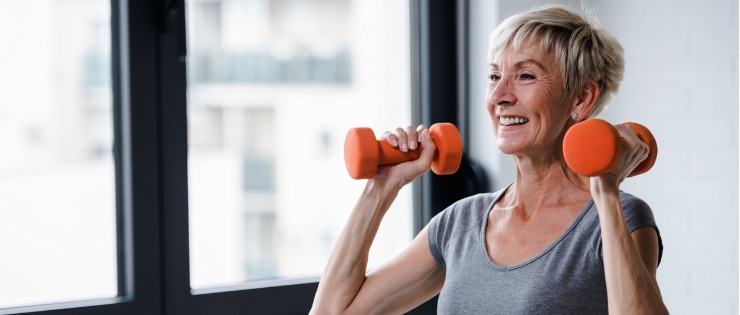
Double Arm Row
This exercise is ideal for building glute, back and arm strength.
Begin with your legs together and sit back into a small squat, engaging the glutes and core muscles. Stretch your arms out in front of the body holding weights with the palms facing the ceiling.
Drawing your elbows back by squeezing your upper back muscles together. Pull the elbows gently past the hips so you feel the lats and triceps engage and slowly return to the starting position with control.
Deadlifts
Completing deadlifts will work the hamstrings and glutes.
Begin with your feet hip width apart and weights facing towards the front of your thighs.
Tighten your abdominals, keep your back flat as you bend slightly through the knees as you lower the dumbbells towards the floor.
Send your butt backwards as you squeeze your glutes, and use your hamstrings to lift and return to an upright position.
Tricep Kickback
Work your tricep muscles with this exercise. If you have a stability ball, do the exercise sitting on the ball to work your core muscles and arms.
Begin with your feet together then sit back into a slight squat with your arms bent at 90-degree angles, and weights at the sides of the chest.
Press the dumbbells back past the hips, keeping the line from your shoulder to your elbow joint stable.
Return to the starting position with weights at 90-degrees.
Do your future self a favour and get started in strength training. A little time devoted to self or weight training from your 50s can greatly improve your health and quality of life in your 80s.
If you haven’t done any strength training but want to get started, you may need to see your GP to get the all clear. If you’re worried about injuring yourself, speak to a personal trainer to help you get started.